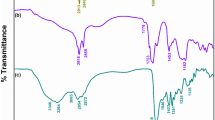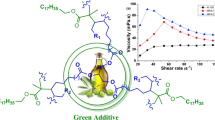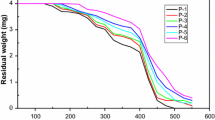Abstract
Three novel multifunctional additives (MFAs), poly(alkyl acrylate-co-maleic anhydride)-based amide copolymers, were synthesized by the reaction between intermediate alkyl acrylate-co-maleic anhydride and three different amines, viz. octylamine (MFA 1), dodecylamine (MFA 2), and octadecylamine (MFA 3). Additives were successfully prepared by the polymerization route using benzoyl peroxide (Bz2O2) as a free radical initiator. Analytical techniques such as Fourier transform infrared, nuclear magnetic resonance, and gel permeation chromatography were used to characterize the synthesized polymeric compounds. Polyol was taken as reference base oil for performance evaluation of the synthesized polymers as multifunctional additive for viscosity index improver, pour point depressant, anti-wear, anti-friction, detergent–dispersant, and anti-corrosion properties. MFA 1 reflected the best performance as detergent–dispersant and anti-corrosive additive with observed increment of ~ 48% and ~ 54%, respectively, in comparison with blank polyol. MFA 3 showed the best viscosity index improving property which enhanced the viscosity index of polyol base oil from 191.85 to 250.45 at 3000 ppm. It also showed best tribological performance in 3000 ppm concentration at which the average wear scar diameter and average friction coefficient values decrease to 482 µm and 0.0823 from the 690 µm and 0.1276 for blank polyol.






Similar content being viewed by others
References
Roy M, Mortier RM, Fox MF, Orszulik ST (2010) Chemistry and technology of lubricants, 3rd edn. Springer, Heidelberg
Leslie RR (2009) Lubricant additives: chemistry and applications. Taylor & Francis Group, Boca Raton
Ludema KC (1996) Friction, wear, lubrication: a textbook in tribology. CRC Press L.L.C., Boca Raton, pp 124–134
Rizvi SQA (2009) A comprehensive review of lubricant chemistry, technology, selection, and design. ASTM International, West Conshohocken, pp 100–112
Ghosh P, Das M (2014) Study of the influence of some polymeric additives as viscosity index improvers and pour point depressant—synthesis and characterization. J Pet Sci Eng 119:79–84
Mohamed SA, Ahmed NS, Hassanein SM, Rashad AM (2012) Investigation of polyacrylates copolymers as lube oil viscosity index improvers. J Petrol Sci Eng 100:173–177
Singh AK, Singh RK (2012) A search for eco-friendly detergent/dispersant additives for vegetable-oil based lubricants. J. Surfactants Deterg 15(4):399–409
Ghosh P, Karmakar G (2012) Synthesis and characterization of polymyristyl acrylate as a potential additive for lubricating oil. Am J Polym Sci 2(1):1–6
Ghosh P, Das T, Karmakar G, Das M (2011) Evaluation of acrylate—sunflower oil copolymer as viscosity index improvers for lube oil. J Chem Pharm Res 3(3):547–556
Karmakar G, Ghosh P (2016) Atom transfer radical polymerization of soybean oil and its evaluation as a biodegradable multifunctional additive in the formulation of eco-friendly lubricant. ACS Sustain Chem Eng 4:775–781
Upadhyay M, Karmakar G, Kapur GS, Ghosh P (2017) Multifunctional greener additives for lubricating oil. Polym Eng Sci 58(5):810–815
Yumin W, Guangdi N, Fei Y, Chuanxian L, Guoliang D (2012) Modified maleic anhydride copolymers as pour-point depressants and their effects on waxy crude oil rheology. Energy Fuels 26:995–1001
Abdel-Azim AAA, Nasser AM, Ahmed NS, Kafrawy AFEI, Kamal RS (2009) Multifunctional additives viscosity index improvers, pour point depressants and dispersants for lube oil. Petrol Sci Techol 27:20–32
Ghosh P, Hoque M, Karmakar G, Yeasmin S (2017) Castor oil-based multifunctional greener additives for lubricating oil. Curr Environ Eng 4(3):197–206
Ghosh P, Talukder S, Upadhyay M, Das T (2016) Multifunctional additive performance of acrylate-styrene copolymers. J Sci Ind Res 75:420–426
Singh RK, Kukrety A, Kumar A, Chouhan A, Saxena RC, Ray SS, Jain SL (2018) Synthesis, characterization and performance evaluation of N, N-Dimethylacrylamide–alkyl acrylate co-polymers as novel multi-functional additives for lube oil. Adv Polym Technol 37(6):1695–1702
Ghosh P, Das M, Upadhyay M, Das T, Mandal A (2011) Synthesis and evaluation of acrylate polymers in lubricating oil. J Chem Eng Data 56:3752–3758
Brandi G, Koch P, Maiorana S, Croce PD, Baldoli C (1986) Multifunctional additive for lubricating oils and process for the preparation thereof. US Patent No. US4618439A
Khalkar S, Bhowmick DN, Pratap A (2013) Synthesis of polymers from fatty alcohol and acrylic acid and its impact on tribological properties. J Oleo Sci 62(3):167–173
ASTM D2270-10 (2016) Standard practice for calculating viscosity index from kinematic viscosity at 40 °C and 100 °C. In: Annual Book of ASTM Standards. ASTM International, West Conshohocken, PA
ASTM D97-17b (2017) Standard test method for pour point of petroleum products. In: Annual Book of ASTM Standards. ASTM International, West Conshohocken, PA
ASTM D4172 (2010) Standard test method for wear preventive characteristics of lubricating fluid (Four-Ball Method). In: Annual Book of ASTM Standards. ASTM International, West Conshohocken, PA
ASTM D7899-13 (2013) Standard test method for measuring the merit of dispersancy of in-service engine oils with blotter spot method. In Annual Book of ASTM Standards. ASTM International, West Conshohocken, PA
Champion FA (ed) (1964) Corrosion testing procedure. Champion & Hall, London, p 66
Ailor WH (ed) (1971) Handbook of corrosion testing and evaluation. Wiley, New York, p 119
ASTM D664-11a (2011) Standard test method for acid number products by potentiometric titration. In: Annual Book of ASTM Standards; ASTM International: West Conshohocken, PA
Singh RK, Kukrety A, Thakre GD, Atray N, Ray SS (2015) Development of new eco-friendly detergent/dispersant/antioxidant/antiwear additives from l-histidine for bio lubricant applications. RSC Adv 5(47):37649–37656
ASTM International (2019) D3228-08(2019) standard test method for total nitrogen in lubricating oils and fuel oils by modified Kjeldahl method. West Conshohocken, PA
Author information
Authors and Affiliations
Corresponding authors
Ethics declarations
Conflict of interest
The authors declare no competing financial interest.
Additional information
Publisher's Note
Springer Nature remains neutral with regard to jurisdictional claims in published maps and institutional affiliations.
Rights and permissions
About this article
Cite this article
Faujdar, E., Negi, H., Kukrety, A. et al. Study of alkyl acrylate-co-maleic anhydride-based novel amide copolymers as multifunctional lubricant additives. Polym. Bull. 78, 2085–2102 (2021). https://doi.org/10.1007/s00289-020-03204-5
Received:
Revised:
Accepted:
Published:
Issue Date:
DOI: https://doi.org/10.1007/s00289-020-03204-5




